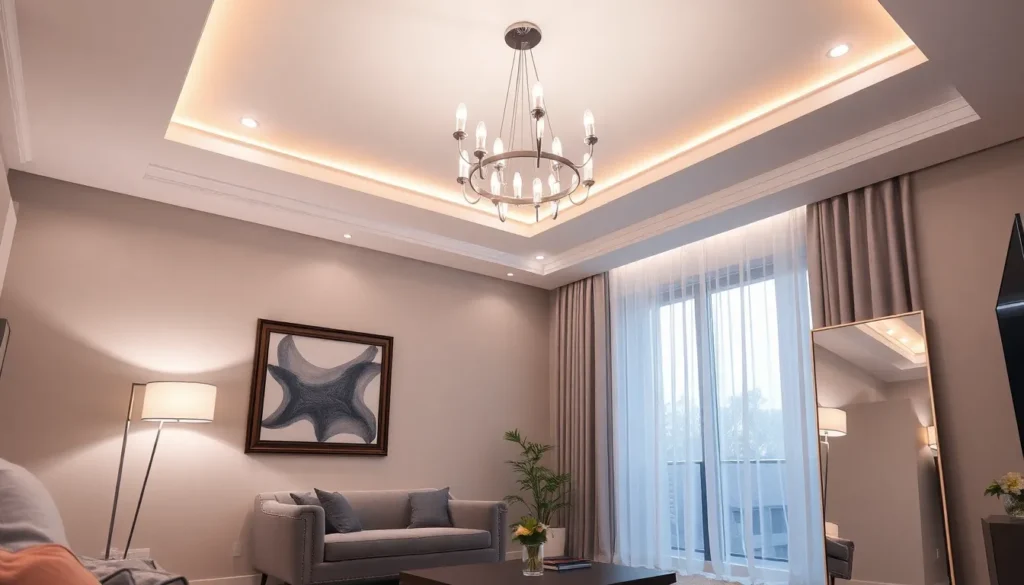We’ve all walked into a beautifully lit living room and felt instantly drawn to its warm ambiance. The right lighting transforms your space from ordinary to extraordinary, creating the perfect atmosphere for everything from movie nights to dinner parties.
Strategic lighting design isn’t just about choosing pretty fixtures—it’s about layering different light sources to enhance your room’s functionality and mood. Whether you’re working with a cozy apartment or a spacious family room, the right combination of ambient, task, and accent lighting makes all the difference.
We’ll explore creative lighting answers that fit every budget and style preference. From statement chandeliers that serve as focal points to subtle LED strips that add modern flair, these ideas will help you create a living space that’s both practical and visually stunning. Ready to illuminate your home’s potential?
Ambient Lighting Ideas for Creating a Warm Living Room Atmosphere
Ambient lighting forms the foundation of any well designed living room lighting scheme. We’ll explore three key approaches that deliver consistent, comfortable illumination throughout your space.
Ceiling-Mounted Fixtures for Overall Illumination
Ceiling mounted fixtures serve as the primary source of ambient light in most living rooms. Chandeliers work beautifully in rooms with high ceilings, creating an elegant focal point while distributing warm light evenly across the space. Pendant lights offer a more contemporary approach, especially when installed in clusters of three or five at varying heights.
Flush mount fixtures provide excellent ambient lighting for rooms with standard 8 foot ceilings. We recommend choosing fixtures with frosted glass or fabric shades to soften harsh shadows and create a welcoming glow. Semi flush fixtures hang slightly lower than flush mounts, adding visual interest while maintaining clean lines.
Consider installing dimmer switches with any ceiling mounted fixture to adjust brightness levels throughout the day. This simple upgrade allows you to transition from bright task lighting during active hours to soft ambient lighting for relaxation or entertainment.
Recessed Lighting for Clean, Modern Appeal
Recessed lighting offers a sleek, minimalist approach to ambient illumination that works particularly well in contemporary living rooms. LED recessed lights consume up to 75% less energy than traditional incandescent bulbs while lasting 25 times longer, making them both cost effective and environmentally friendly.
Spacing matters when installing recessed lights for optimal ambient coverage. We typically recommend placing fixtures 4 to 6 feet apart in a grid pattern, with lights positioned 18 to 24 inches from walls to prevent harsh shadows. Adjustable trim options allow you to direct light where it’s needed most while maintaining the clean aesthetic.
Color temperature plays a crucial role in creating warmth with recessed lighting. Choose bulbs in the 2700K to 3000K range for a cozy, inviting atmosphere that complements most living room color schemes. Smart dimming capabilities let you program different lighting scenes for various activities throughout the day.
Floor Lamps for Soft, Diffused Light
Floor lamps excel at providing gentle ambient lighting while adding style and personality to your living room. Torchiere lamps direct light upward toward the ceiling, creating soft, reflected illumination that eliminates harsh shadows and bright spots.
Arc floor lamps curve gracefully over seating areas, combining ambient and task lighting functions in one elegant fixture. These work especially well behind sofas or chairs where they can provide reading light while contributing to overall room brightness. Tripod floor lamps with fabric shades offer a mid century modern aesthetic while diffusing light beautifully throughout the space.
Multiple floor lamps strategically placed around your living room create layers of ambient light that feel more natural than a single overhead fixture. We suggest using lamps of varying heights and styles to add visual interest while maintaining consistent warm light output across the room.
Task Lighting Solutions for Functional Living Room Spaces
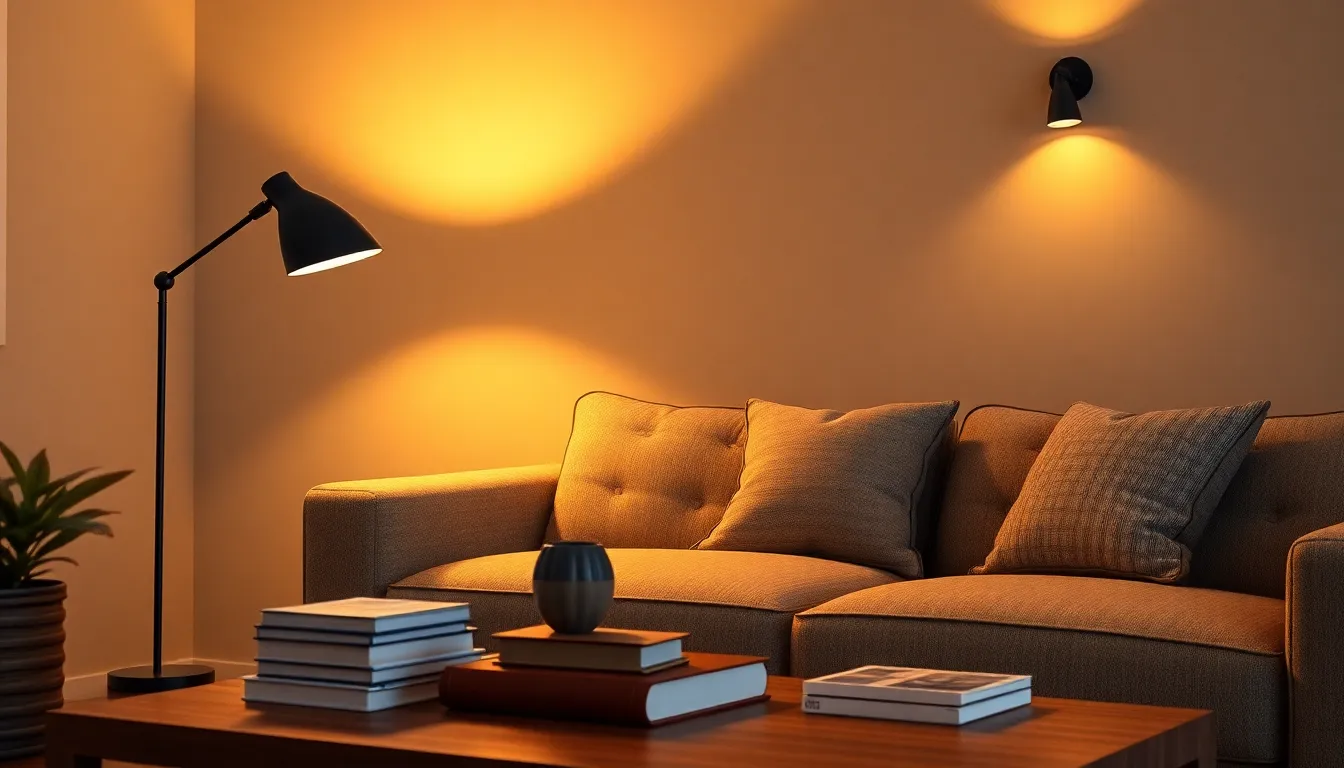
Building on our ambient lighting foundation, task lighting brings focused illumination to exact activities and areas where precision matters most.
Table Lamps for Reading and Close-Up Work
Table lamps deliver concentrated light exactly where we need it for reading, puzzles, or detailed work. We recommend placing these fixtures on side tables or end tables positioned within arm’s reach of seating areas to ensure optimal light direction without creating harsh shadows.
Positioning strategies maximize effectiveness when we angle the lampshade to direct light downward and slightly forward. This approach prevents glare while illuminating books, magazines, or create projects clearly. Adjustable table lamps offer the most versatility, allowing us to customize the light angle based on our current activity.
Bulb selection plays a crucial role in task lighting performance. We suggest using LED bulbs with 2700K to 3000K color temperature for warm, comfortable reading light that won’t strain our eyes during extended use.
Wall-Mounted Sconces for Targeted Illumination
Wall-mounted sconces provide focused lighting while freeing up valuable table space in our living rooms. These fixtures excel at creating layers of light at different heights throughout the room.
Picture sconces highlight exact objects like artwork or bookshelves while casting a softer glow across surrounding areas. We position these fixtures 6 to 12 inches above artwork or 12 to 18 inches away from bookshelves to prevent shadows from interfering with visibility.
General sconces add ambient light and can be installed at various heights to create sophisticated lighting layers. Installing these fixtures at 60 to 66 inches from the floor ensures optimal light distribution without creating harsh shadows on our faces.
Pendant Lights Over Exact Areas
Pendant lights deliver direct, focused illumination to designated zones within our living spaces. These hanging fixtures work exceptionally well over coffee tables, dining areas, or workspaces where concentrated light enhances functionality.
Pendant fixtures should hang 28 to 32 inches above coffee tables and 30 to 36 inches above dining tables to provide adequate illumination without obstructing conversation or movement. We choose pendant styles that complement our existing decor while delivering the light output needed for exact tasks.
Multiple pendant installations create visual interest and balanced lighting across larger areas. Spacing these fixtures 24 to 30 inches apart ensures even light distribution while maintaining a cohesive design aesthetic throughout our living room space.
Accent Lighting Options to Highlight Living Room Features
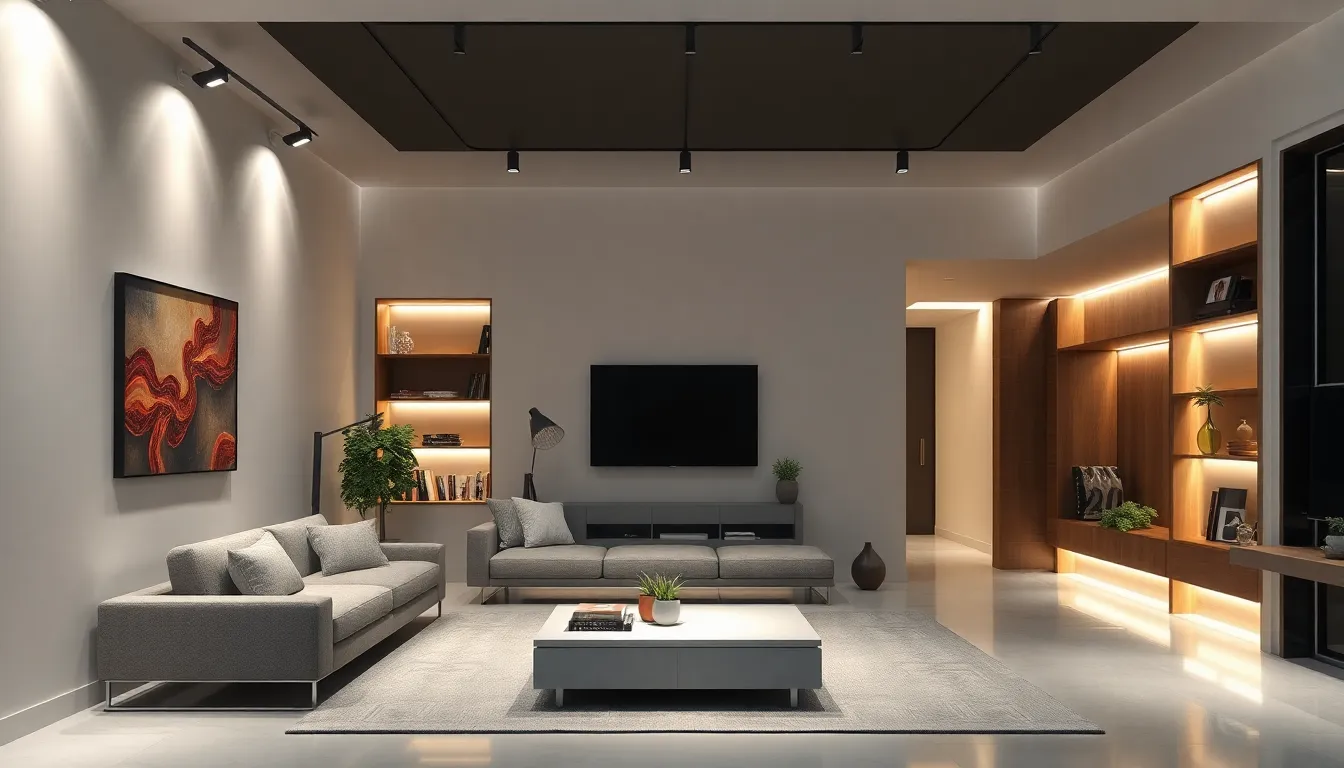
Accent lighting transforms ordinary living spaces into ever-changing environments by drawing attention to exact architectural elements and decorative pieces. We’ll explore three versatile accent lighting answers that add depth and visual interest to your living room design.
Track Lighting for Artwork and Decor
Track lighting systems offer unmatched flexibility for showcasing your favorite artwork and decorative elements. We can easily adjust these fixtures to direct light exactly where it’s needed, whether illuminating a gallery wall or highlighting a stunning sculpture.
Flexible direction makes track lights incredibly versatile, allowing us to shine light on various decorative pieces throughout the room. We can reposition individual fixtures along the track to accommodate new artwork or seasonal decorations without rewiring.
Adjustable focus enables us to change the lighting direction as our decor evolves. This adaptability means we’re not locked into one lighting configuration, making track systems perfect for renters or anyone who enjoys refreshing their space regularly.
LED Strip Lights for Architectural Details
LED strip lights excel at accentuating your living room’s architectural features while providing energy efficient illumination. We can install these flexible strips in countless locations to create dramatic lighting effects that highlight unique design elements.
Highlighting textures becomes effortless with LED strips placed behind furniture or along wall edges. We can illuminate textured walls, exposed beams, or built in shelving to add depth and visual interest to otherwise flat surfaces.
Energy efficiency makes LED strips an economical choice for continuous accent lighting. We can run these strips for hours without worrying about electricity costs, and their easy installation under furniture or along staircases means we won’t need professional help.
Uplighting to Emphasize Ceiling Height
Uplighting creates the illusion of spaciousness by drawing the eye upward and making our living rooms feel larger than their actual dimensions. We can strategically place these fixtures to add dramatic flair while improving the room’s perceived height.
Ceiling fixtures that direct light upward work particularly well in rooms with standard height ceilings. We install these fixtures to bounce light off the ceiling surface, creating a soft glow that makes the space feel more open and airy.
Dramatic effect results from this upward light direction, which draws attention to the ceiling and creates visual interest above eye level. We achieve this spacious feeling by positioning uplights in corners or behind furniture, where they can wash the ceiling with gentle illumination.
Layered Lighting Approaches for Dynamic Living Room Design
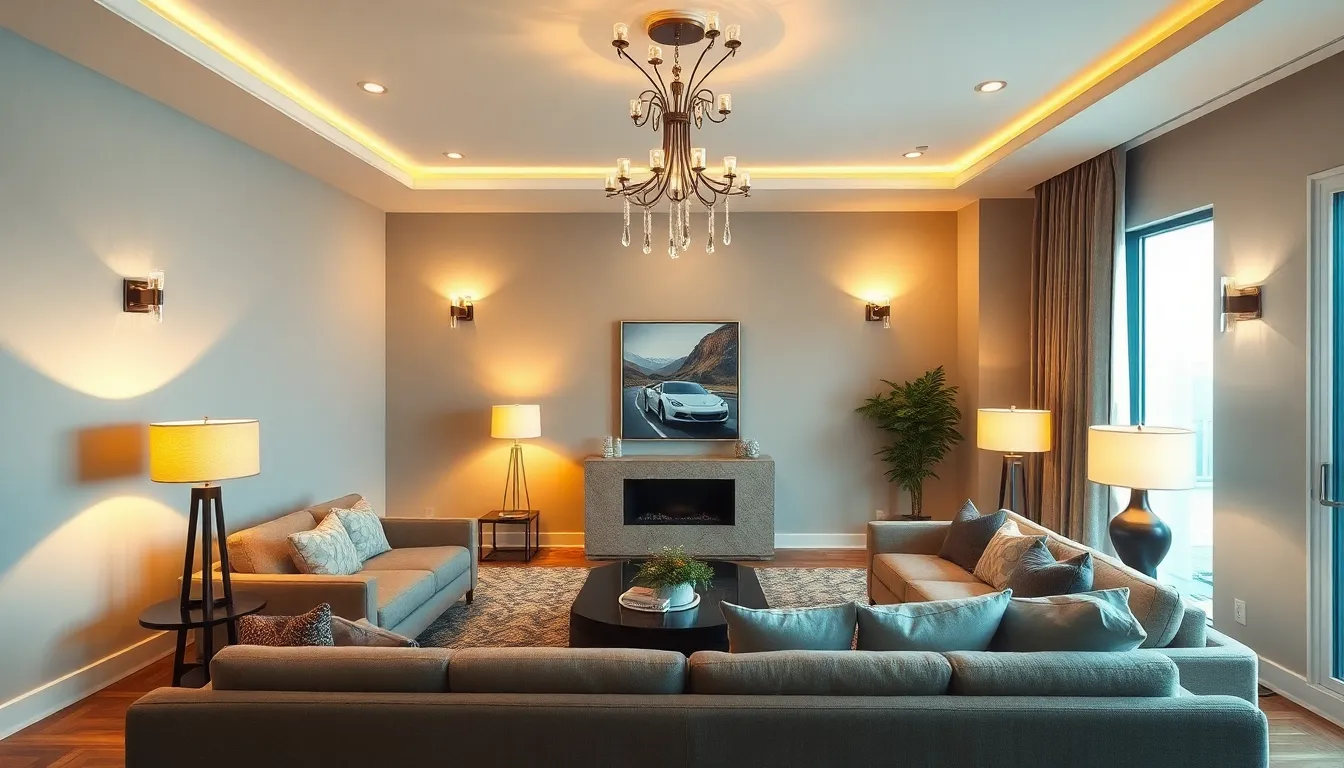
We’ve explored individual lighting types, but the real magic happens when we combine ambient, task, and accent lighting into a cohesive layered system. This approach transforms your living room from a single-note space into a ever-changing environment that adapts to different activities and moods throughout the day.
Combining Multiple Light Sources for Depth
Strategic placement of different fixtures creates visual depth that makes your living room feel more spacious and sophisticated. We recommend starting with overhead lighting like chandeliers or ceiling fixtures as your ambient foundation, then adding floor and table lamps to bring illumination closer to eye level.
Wall sconces contribute another layer by casting light at mid-height, which breaks up the monotony of only having light sources at floor and ceiling levels. Backlighting behind furniture or artwork creates subtle drama and makes objects appear to float, adding an unexpected design element that guests always notice.
The key lies in distributing these light sources throughout the room rather than clustering them in one area. Position table lamps on side tables, place floor lamps in corners, and install sconces flanking a sofa or artwork to achieve balanced illumination from multiple angles.
Mixing Warm and Cool Light Temperatures
Temperature variation adds complexity to your lighting scheme while serving practical purposes in different areas of your living room. Warm lighting in the 2700K to 3000K range creates cozy atmospheres perfect for relaxation zones, while cool lighting between 3500K and 5000K enhances focus in work areas.
We suggest using warm lighting for your primary seating area where you’ll spend time unwinding after work or entertaining guests. Task areas like reading nooks or home office corners benefit from cooler temperatures that reduce eye strain and maintain alertness.
Dimmable fixtures give you the flexibility to adjust both brightness and apparent temperature throughout the day. Morning hours might call for brighter, cooler light to energize your space, while evening entertainment benefits from warmer, softer illumination that encourages conversation and relaxation.
Creating Zones with Different Lighting Levels
Dividing your living room into functional zones allows each area to serve its intended purpose while maintaining visual harmony across the entire space. Your seating zone requires soft, ambient lighting that promotes relaxation without creating harsh shadows on faces during conversation.
Work zones demand brighter, more focused illumination to support activities like reading, crafting, or laptop use. Position task lighting to eliminate shadows on your work surface while avoiding glare that causes eye fatigue during extended periods of concentration.
Display zones showcase your artwork, collectibles, or architectural features through carefully positioned accent lighting. These areas typically need less overall brightness but benefit from precise beam angles that highlight textures and create visual interest without overwhelming the surrounding space.
Each zone should have independent controls so you can adjust lighting levels based on current activities. Installing separate switches or smart controls for different areas lets you create the perfect atmosphere whether you’re hosting a dinner party or settling in for a quiet evening at home.
Smart Lighting Technology for Modern Living Room Control
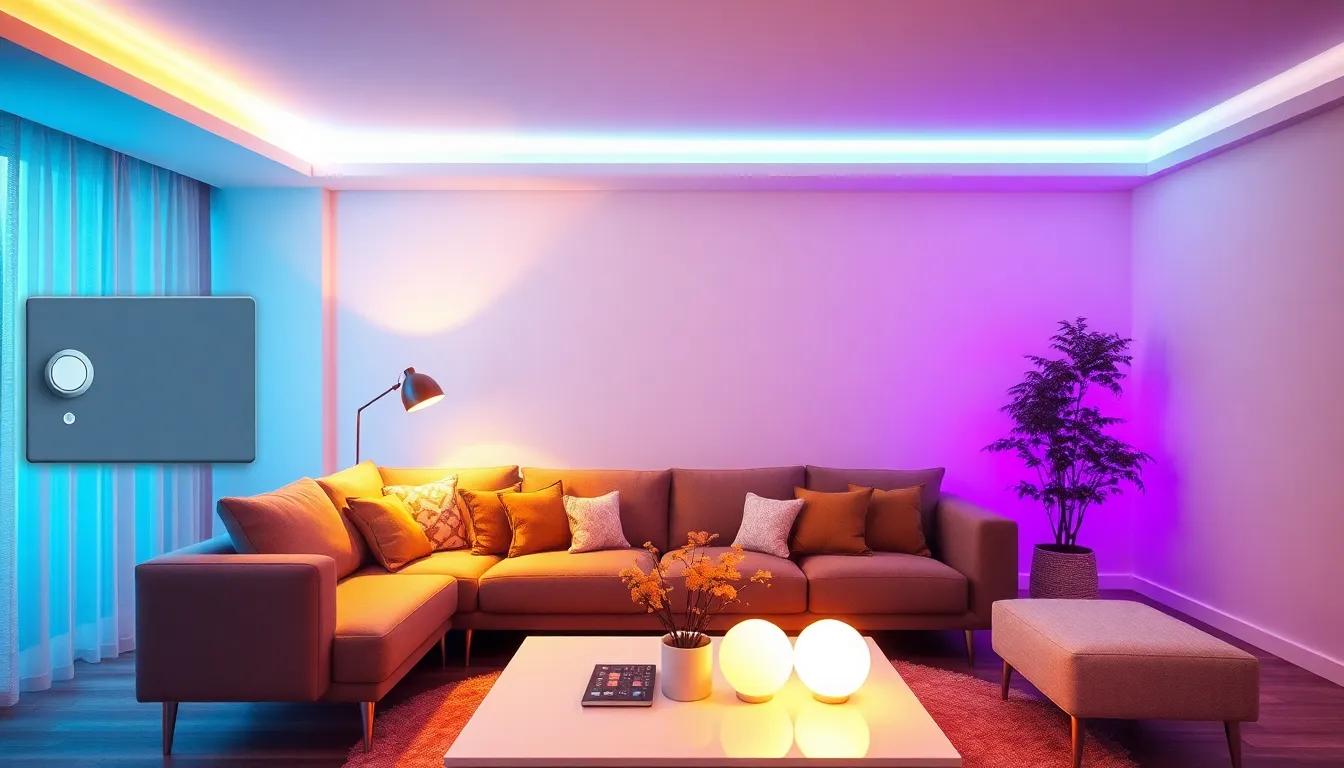
Modern living rooms benefit significantly from advanced smart lighting systems that provide comprehensive control and automation capabilities. These intelligent answers transform how we interact with our lighting while offering energy efficiency and convenience.
Dimmer Switches for Adjustable Brightness
Traditional dimmers provide manual adjustment of light intensity across multiple brightness levels suitable for different activities throughout the day. Installing these switches allows us to create the perfect ambiance whether we’re hosting dinner parties or enjoying quiet movie nights at home.
Smart dimmers integrate seamlessly with home automation systems and offer remote control capabilities through smartphone apps. These advanced units can be programmed to exact scenes or schedules, automatically adjusting brightness based on time of day or room occupancy. Leading brands like Lutron and Control4 offer sophisticated dimming answers that learn our preferences and adapt accordingly.
Remote dimming control eliminates the need to manually adjust switches when we’re already comfortable on the couch. Smart dimmers also provide energy savings by reducing power consumption during low-light activities like watching television or reading.
Smart Bulbs for Color and Temperature Changes
Color-changing bulbs from brands like Philips Hue transform our living rooms with millions of color options and customizable lighting scenes. These innovative bulbs enhance mood and ambiance by shifting from vibrant party colors to soft pastels for relaxation.
Temperature adjustment capabilities allow smart bulbs to shift between warm and cool white light throughout the day. Morning hours benefit from cooler, energizing light that mimics natural daylight, while evening settings call for warmer tones that promote relaxation and comfort.
Automated color temperature changes sync with our circadian rhythms, supporting better sleep patterns and overall wellbeing. Programming these bulbs to gradually warm up in the evening helps signal our bodies to prepare for rest.
Voice-Controlled Lighting Systems
Integration with smart speakers enables hands-free lighting control through Alexa, Google Assistant, or Apple HomeKit commands. Companies like Control4 and aspectLED offer comprehensive voice-activated systems that respond to natural language commands for adjusting brightness, colors, and scenes.
Voice commands provide convenient lighting adjustments when our hands are occupied with cooking, cleaning, or entertaining guests. Simple phrases like “dim the living room lights” or “set romantic lighting” instantly create the desired atmosphere without interrupting our activities.
Hands-free operation proves especially valuable during nighttime hours when we need gentle illumination without fully waking up. Voice control systems can activate pathway lighting or gradually increase brightness to ease the transition from sleep to wakefulness.
Budget-Friendly Living Room Lighting Ideas That Make an Impact
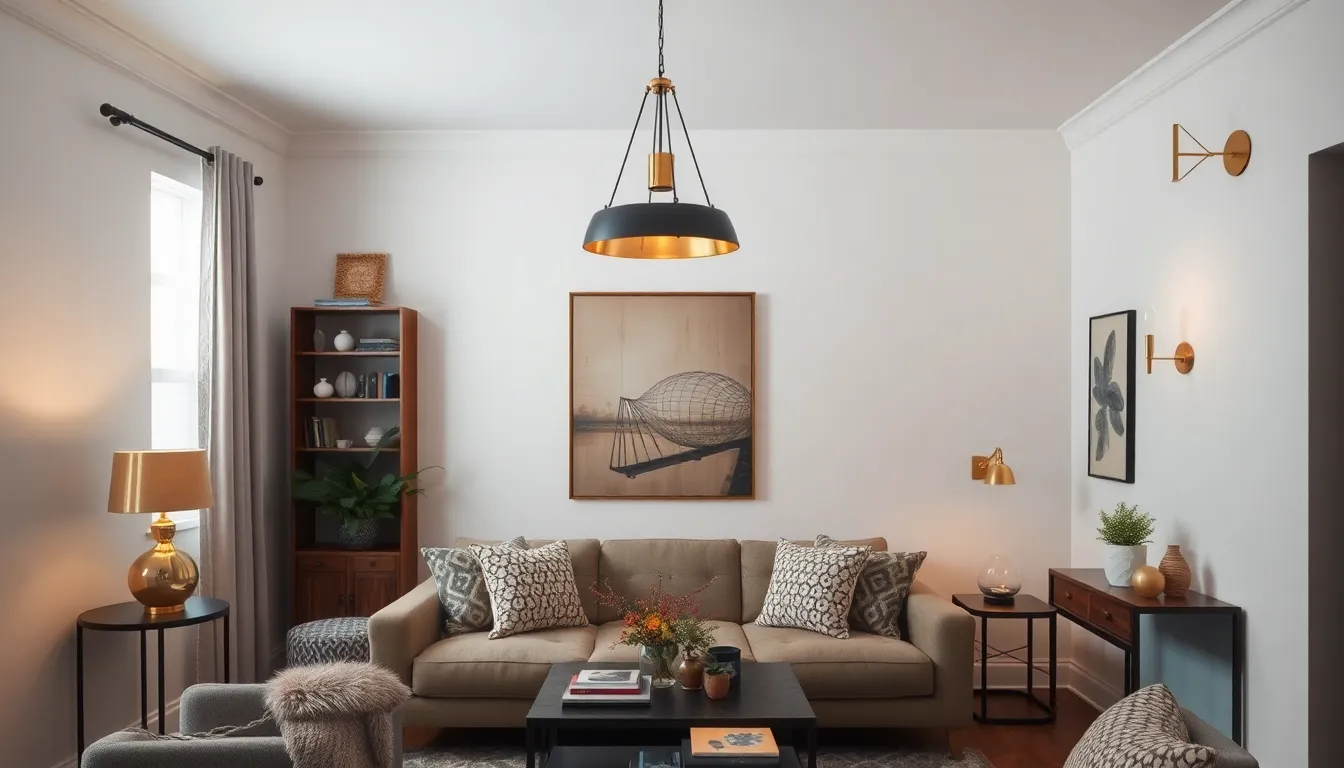
Creating stunning living room lighting doesn’t require a hefty budget when you know where to look and how to get creative. Smart shopping strategies and DIY approaches can deliver the same visual impact as expensive designer fixtures.
DIY Lighting Projects for Custom Answers
Cord covers transform plug-in fixtures into professional-looking installations while keeping costs minimal. We’ve found that using cord covers to tidy up lamp placement creates a custom, built-in appearance that rivals expensive hardwired fixtures.
Track lighting systems offer flexible accent lighting answers you can install yourself. DIY track lighting or strip lights provide targeted illumination for artwork, architectural features, or reading areas without the expense of professional electrical work.
Custom lamp shades personalize inexpensive base lamps with unique character and style. Crafting your own shades using fabric, paint, or thrifted materials transforms basic fixtures into conversation pieces that reflect your personal aesthetic.
Upcycled materials create one-of-a-kind light fixtures from everyday objects. Repurposing jars, baskets, or industrial parts into pendant lights or table lamps delivers unique lighting answers that can’t be found in any retail store.
Thrift Store Finds and Upcycling Options
Vintage and secondhand lighting provides designer-quality fixtures at fraction-of-retail prices. Thrift stores frequently feature lamps, chandeliers, and sconces that need only minor updates like new shades, fresh paint, or rewiring to look completely refreshed.
Eclectic mixing combines different textures and finishes from thrifted finds to create cohesive lighting schemes. Pairing a brass table lamp with a ceramic pendant or mixing metal finishes adds character while maintaining visual harmony throughout your space.
Restoration projects turn dated fixtures into contemporary showpieces with minimal investment. Simple updates like spray painting metalwork, replacing fabric shades, or adding Edison bulbs can completely transform secondhand lighting into modern statement pieces.
Affordable Fixtures That Look Expensive
IKEA and big-box retailers offer stylish ceiling lights, pendants, and chandeliers that mimic high-end designs. These stores provide sophisticated lighting options at budget prices, making designer looks accessible without designer price tags.
Mixed metal finishes create visual interest and designer appeal without increased costs. Combining iron chandeliers with bronze lamps or brass accents adds depth and sophistication that suggests a more expensive, curated lighting collection.
Minimalist fixtures maintain modern, sophisticated appearances while keeping prices low. Simple sconces, clean-lined pendants, and tonal fixtures deliver contemporary style without ornate details that drive up manufacturing costs.
Strategic placement maximizes the impact of affordable fixtures throughout your living space. Positioning budget-friendly lamps next to reading chairs, placing candles on mantels and coffee tables, or draping string lights across ceilings creates layered lighting that feels intentional and expensive.
Statement Lighting Pieces to Transform Your Living Room
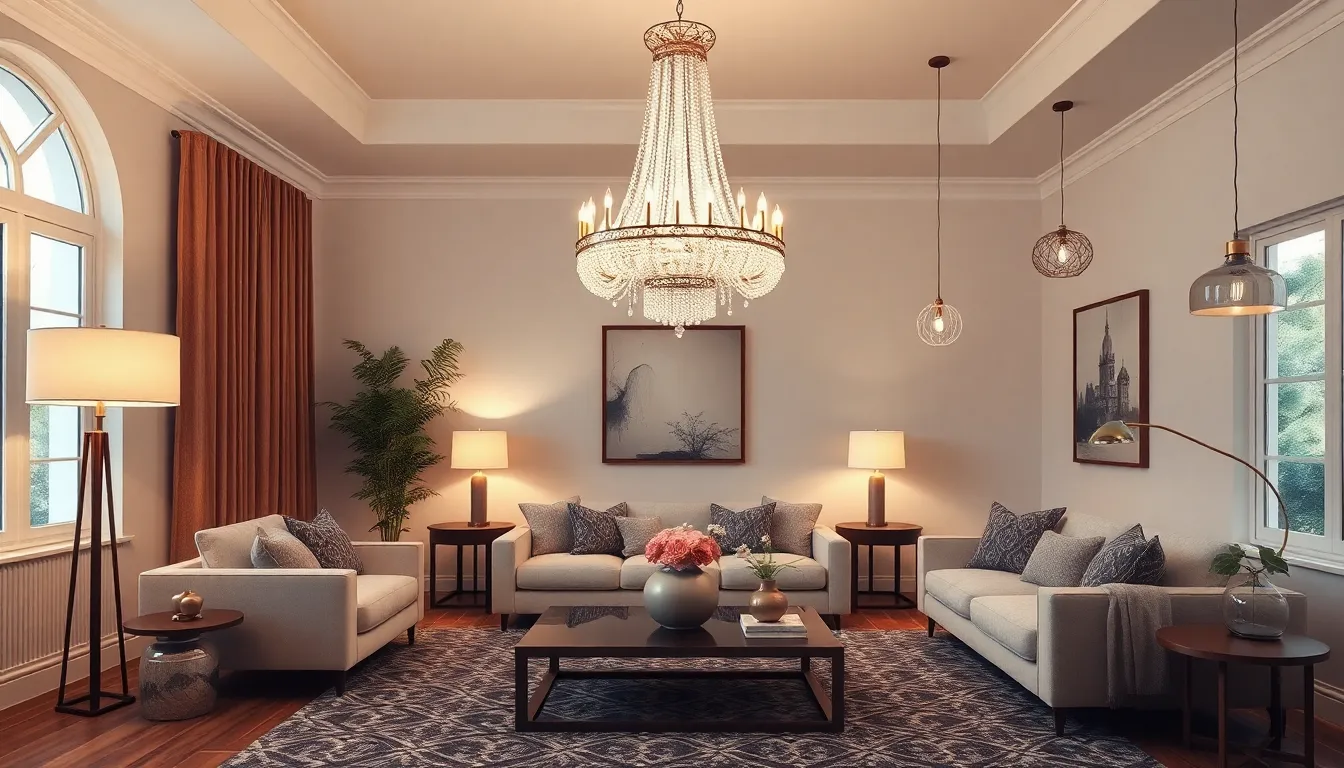
Statement lighting pieces serve as the centerpiece of our living room design, creating dramatic visual impact while providing essential illumination. These bold fixtures become conversation starters that define our space’s personality and style.
Chandeliers as Dramatic Focal Points
Chandeliers instantly elevate our living room’s elegance and create a stunning focal point that draws the eye upward. We can choose from modern geometric designs, traditional crystal styles, or rustic wrought iron pieces to match our room’s aesthetic perfectly. Modern chandeliers work beautifully in contemporary spaces with clean lines, while traditional crystal options add timeless sophistication to formal living areas.
Positioning becomes crucial when we install chandeliers in our living room spaces. We should hang them approximately 7 feet from the floor in rooms with standard 8-foot ceilings, adjusting higher for taller spaces. Large living rooms benefit from oversized chandeliers that fill the space proportionally, while smaller rooms require more delicate pieces that won’t overwhelm the area.
Oversized Floor Lamps for Bold Style
Oversized floor lamps provide important illumination while making a bold design statement in our shared living areas. We can place these dramatic pieces in corners to brighten dark spaces or position them near seating areas to create cozy reading nooks. Arc floor lamps extend over sofas and chairs, delivering focused light exactly where we need it most.
Scale matters when we select oversized floor lamps for our living rooms. We should choose lamps that stand 60 to 72 inches tall to create proper visual weight in spacious rooms. Tripod designs add modern architectural interest, while drum shade styles provide wide light distribution that fills entire seating areas with warm, ambient illumination.
Unique Pendant Lights for Conversation Starters
Pendant lights create visual interest and stimulate conversation when we hang them strategically throughout our living spaces. We can cluster multiple pendants at varying heights above coffee tables to establish intimate gathering zones. Geometric shapes, artistic glass designs, and sculptural metalwork transform functional lighting into captivating art pieces.
Placement height determines both functionality and visual impact when we install pendant lights in our living rooms. We should hang pendants 30 to 36 inches above coffee tables to provide adequate task lighting without obstructing conversation. Multiple pendants work best when spaced 24 to 30 inches apart, creating rhythm and balance that enhances our room’s overall design flow.
Natural Light Enhancement Ideas for Brighter Living Rooms

Natural light transforms our living spaces into bright, welcoming environments that feel more spacious and energizing. We can dramatically improve our room’s atmosphere by maximizing the daylight that enters through strategic enhancements and thoughtful design choices.
Window Treatments That Maximize Daylight
Sheer curtains create the perfect balance between privacy and natural light penetration. We recommend installing light filtering blinds or sheer panels that allow diffused sunlight to illuminate our living rooms while maintaining the comfortable ambiance we desire.
Layered window treatments offer maximum flexibility for controlling natural light throughout the day. We can combine sheer curtains with heavier drapes, pulling back the dense fabrics during daylight hours to welcome sunshine while keeping the lighter treatments for privacy.
Strategic curtain placement extends beyond the window frame to create an illusion of larger windows. We suggest mounting curtain rods wider and higher than the actual window opening, allowing maximum light exposure when treatments are drawn back.
Mirrors to Reflect and Amplify Natural Light
Reflective surfaces multiply the impact of available natural light by bouncing sunlight throughout our living rooms. We position mirrors directly across from windows to capture and redirect daylight into darker corners and shadowed areas.
Large mirrors create dramatic lighting effects while making our spaces feel significantly larger and brighter. We recommend placing oversized mirrors on walls perpendicular to windows, creating cross reflections that distribute light more evenly across the entire room.
Multiple smaller mirrors work together to create a network of light reflection points. We can arrange collections of mirrors at varying heights and angles to maximize the bouncing effect and create interesting visual patterns with natural light.
Light-Colored Surfaces for Better Light Distribution
Light colored walls reflect and amplify the natural light entering our living rooms, creating a foundation for brighter spaces. We choose whites, creams, and pale pastels that bounce sunlight effectively rather than absorbing it like darker hues.
Glossy finishes enhance light reflection more effectively than matte surfaces in our lighting design strategy. We incorporate satin or semi gloss paint finishes on walls and trim work to maximize the reflective properties that distribute natural light throughout the room.
Metallic decor elements add sparkle and reflection points that work with natural light to create ever-changing illumination. We integrate brass fixtures, chrome accents, and metallic picture frames that catch and redirect sunlight, contributing to the overall brightness of our living spaces.
Conclusion
We’ve covered everything you need to transform your living room with thoughtful lighting design. From layering ambient task and accent lighting to incorporating smart technology and statement pieces your space can become both functional and visually stunning.
Remember that great lighting doesn’t require a massive budget. Whether you’re investing in a show-stopping chandelier or crafting DIY answers the key is understanding how different light sources work together to create depth and atmosphere.
Start with one or two changes that speak to your style and needs. Your living room lighting journey begins with a single switch and the possibilities are endless when you apply these proven strategies.
Frequently Asked Questions
What are the three main types of lighting for living rooms?
The three main types are ambient, task, and accent lighting. Ambient lighting provides overall illumination through ceiling fixtures, recessed lights, or floor lamps. Task lighting offers focused light for specific activities using table lamps, sconces, or pendant lights. Accent lighting adds visual interest and highlights features through track lights, LED strips, or uplighting.
How do I create layered lighting in my living room?
Create layered lighting by combining ambient, task, and accent lighting sources at different heights and positions. Use ceiling fixtures for general illumination, add table or floor lamps for specific tasks, and incorporate accent lights to highlight artwork or architectural features. Install dimmer switches to adjust brightness levels for different moods and activities.
What are the best budget-friendly lighting options?
Budget-friendly options include shopping at retailers like IKEA, DIY projects like custom lampshades, upcycling materials into unique fixtures, and finding vintage pieces at thrift stores. Use cord covers for a polished look, install DIY track lighting, and mix different textures and finishes to create cohesive schemes without expensive fixtures.
How can smart lighting improve my living room?
Smart lighting offers adjustable brightness through dimmer switches, color and temperature changes with smart bulbs, and voice-controlled systems for hands-free operation. These features allow you to create perfect ambiance for different activities, support circadian rhythms, integrate with home automation systems, and save energy through remote smartphone control.
What’s the best way to maximize natural light in my living room?
Maximize natural light using sheer curtains or layered window treatments, strategically placed mirrors to reflect light, and light-colored surfaces with glossy finishes. Add metallic decor elements for extra sparkle and avoid heavy, dark window coverings that block daylight. Position mirrors opposite or adjacent to windows for optimal light amplification.
How do I choose the right chandelier for my living room?
Select a chandelier based on room size, ceiling height, and style preferences. Ensure proper scale – the fixture shouldn’t overwhelm the space or appear too small. Install at appropriate height (typically 7-8 feet from floor in living rooms) and consider dimmer switches for versatility. Choose designs that complement your existing decor and furniture.
What are the benefits of LED lighting for living rooms?
LED lights offer energy efficiency, longer lifespan, and versatile color temperature options. They produce less heat, come in various forms including strips and bulbs, and work well with smart home systems. LEDs provide excellent light quality for both ambient and accent lighting while reducing electricity costs and maintenance needs.
How should I space recessed lights in my living room?
Space recessed lights 4-6 feet apart for even illumination, positioning them away from walls to avoid harsh shadows. Consider room size and ceiling height when determining quantity and spacing. Use LED bulbs with appropriate color temperature (2700K-3000K for warm ambiance) and install on dimmer switches for adjustable brightness levels.

